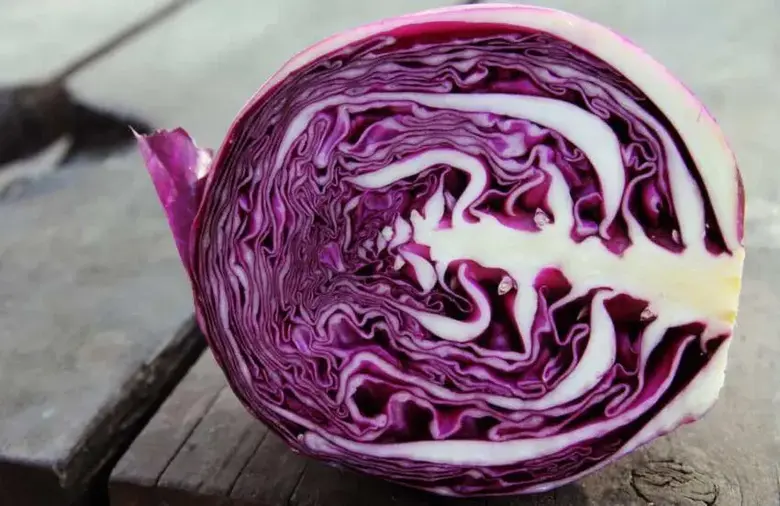How to freeze cabbage - The best way

Cabbage rarely gets the attention it deserves. Many people overlook cabbage because they tend to associate it as a vegetable that you don’t know what to do with.
Sure, there are traditional things you can do with cabbage, like making corned beef brisket or making cabbage soup, but cabbage is actually quite versatile. It’s easy to use, it can taste great if you’re willing to work with it, and it’s incredibly affordable.
Cabbage is very versatile. There are many things you can do with cabbage. We will discuss them in more detail later. But what you should know is that cabbage has many options. Don’t cross it off your list of delicious foods just yet.
A little cabbage goes a long way. It seems that if you buy a head of cabbage, you never use it all before it goes bad. How is this fixed?
Can cabbage be frozen? Yes, you can freeze raw or blanched collards. Blanched cabbage will last in the freezer for up to 9 months, while raw cabbage will only keep in the freezer for 8 weeks. We recommend washing the cabbage before freezing it.
Throughout this guide, we’ll walk you through everything you need to know about how to freeze cabbage. We’ll also share with you some delicious tips and tricks for using your cabbage, as well as using it after you’ve frozen it.
Stay tuned to learn how to freeze cabbage and much more.
The Complete Guide to Freezing Cabbages
Cabbage is incredibly easy to work with. Also, there is no right or wrong way to use it. There are many traditional dishes that cabbage is used in, but you can also incorporate cabbage into any number of homemade dishes.
Cabbage doesn’t have a strong flavor, which makes it easy to work with and you can cook it and flavor it however you like.
Proper cabbage storage and care
Cabbage is relatively easy to work with, as we have already discussed. It is also relatively easy to care for and store properly. Cabbage lasts a long time if stored correctly. It freezes well and usually has a good life cycle in the fridge as well.
Whether you store sliced cabbage, whole cabbage, or shredded cabbage, the processes are fairly straightforward. The most important thing to keep in mind is that you will want to store cabbage airtight.
Properly wrapping, sealing, and storing cabbage will help prevent the growth of bacteria that could lead to things like listeria and salmonella. If you handle cabbage correctly, this shouldn’t be much of a problem to worry about.
One way I like to store cabbage is to use reusable beeswax food wraps.
You can start by storing the cabbage in the fridge and this works well for up to 5 days. If you do not plan to use it in 5 days, we recommend that you freeze the cabbage. If you’ve bought cabbage in bulk, freezing it is also a great option.
You can freeze cabbage without blanching it, but the shelf life is much better if you blanch it first.
Let’s talk about proper storage in the refrigerator, and then we’ll talk about freezing blanched and non-blanched cabbage.
Storage of cabbage in the refrigerator
- Wrap the cabbage well. Wrap it in plastic wrap, then seal it in an airtight container or storage bag (like this set from Amazon). My favorite thing to use for this is reusable food wrap; I use these from Etee.
- Store cabbage in the crispest drawer or area of your fridge for best results.
- If it is well sealed and in the crunchiest part of the refrigerator, you can keep the cabbage for about 5-7 days.
- When you are going to use the cabbage, it is best to discard the outer layer of the leaves (whether it is sliced or whole cabbage).
How to freeze cabbage: The best way
There are two ways to freeze cabbage. In our opinion, blanching the cabbage before freezing it is the best way to go, because it will ensure better quality for longer.
How to Freeze Cabbage After Blanching (Recommended)
If you are going to freeze the cabbage, we recommend blanching it first . We’ll also share how to freeze without blanching in case that’s your preference.
- Wash and rinse the cabbage . If you can, save your whole head of cabbage with the bulb attached. To clarify it, it is best to use a soaking process. Add a small amount of salt to the water and let the cabbage soak for 1-3 hours.
- If you’re freezing shredded or sliced cabbage, you can skip the soaking process, since you’ve most likely already done some sort of cleaning on the cabbage.
- Cut the cabbage into slices, cubes or strips and divide it into portions. You can also freeze it whole with the bulb intact for the best results.
- Blanch the cabbage by cooking it in a pot of boiling water for 2-3 minutes . Immediately transfer the cabbage to ice water to stop the cooking process. This small step goes a long way in keeping cabbage in the freezer.
- Prefreeze the cabbage on a baking tray . Pre-freezing is not necessary if your cabbage is whole. Spread it out on a cookie sheet and freeze it for about 6-8 hours.
- Wrap the cabbage in plastic wrap . Place the cabbage in an airtight container or heavy-duty freezer bag.
- Label, date, and seal all cabbage wrappers.
- Freeze cabbage for up to 9 months.
How to freeze cabbage without blanching it
You can freeze cabbage without blanching it. The biggest drawback to freezing it without blanching it is that it won’t keep as long in the freezer.
This is the process for freezing cabbage without blanching it.
- Rinse and soak the cabbage.
- Determine if you are freezing the cabbage whole, diced, sliced, or shredded, and prepare accordingly.
- Pre-freeze the cabbage if you are not going to freeze it whole. To do this, spread it on a baking tray and freeze it for about 6-8 hours uncovered.
- Wrap cabbage portions in plastic wrap and place in an airtight container or heavy-duty freezer bag.
- Label, date, and seal the cabbage container.
- Freeze cabbage that has not been blanched for up to 8 weeks for best results.
The processes are simple and direct. The process you use is entirely up to you. Your decision can also be affected by how long you intend to keep the cabbage in the freezer.
How to use frozen cabbage: Do you have to thaw it?
One of the best things about using cabbage after it has been frozen is that the process is quite simple.
You do not have to thaw the cabbage . When you’re ready to use it, you can transfer it directly from the fridge to your power supply.
If you intend to use the cabbage raw after freezing it, it may be worth letting it thaw for a few hours in the fridge, or up to 1 hour at room temperature.
However, if it’s not too frozen to work with, you can proceed to prepare the cabbage however you like.
cooking with frozen cabbage
There are so many delicious things you can do with cabbage. For starters, you can rinse it and use it raw in a number of ways. You can also cook it in a variety of ways and add it to numerous dishes.
Ultimately, how you prepare and eat cabbage will vary based on your personal preferences and cooking styles.
Here are some ideas for using cabbage . These ideas contain both fresh cabbage and cooked cabbage. Some of them may seem familiar to you, while others may be new ideas to you.
- Cabbage wraps (stuffed with meat, cheese, vegetables, etc.)
- Sauté and season the cabbage
- Sausage and fried cabbage
- Cabbage Soup
- Cabbage salad
- Oven Roasted Cabbage Slices with Seasonings
- Corned beef brisket and cabbage
- cabbage rolls
- use in salads
- Use in stir-fries
- Use shredded cabbage for fish or shrimp tacos
- Add to various casserole dishes
- Mix it in the tuna salad
These are just a few examples of things you can do with cabbage. Don’t limit yourself to a few cabbage dishes. Keep in mind that you can do almost anything you want with cabbage.
If you don’t use fresh cabbage, cooking cabbage is pretty straightforward. The good thing about cabbage is that there are many things you can do with fresh cabbage, but also many things you can do with cooked cabbage.
There are multiple ways to cook cabbage for certain meals. The most common ways to cook cabbage are to boil it and sauté it.
For quick reference, we want to share with you a quick guide to sautéing cabbage. Keep in mind that there are numerous ways to cook cabbage, this is just a simple example of a common way to cook cabbage.
Here are the instructions for sautéing the cabbage:
- You will need sliced or shredded cabbage, oil, seasonings to taste, and meat if you want to add it.
- Heat the oil in a skillet over medium heat.
- Add the cabbage to the pan and oil.
- From here, you can season to your liking. You can add more vegetables or even meat if you wish.
- Sauté the cabbage, stirring continuously, for about 5 minutes.
- The cabbage may start to brown slightly and will also be mushy.
- Serve and enjoy.
Once again, we remind you that this is just a simple way to prepare the cabbage if you want it cooked. Don’t forget there are many things you can do with raw or fresh cabbage, which is where our freezing processes come into play.
You can freeze cooked cabbage, but ultimately this guide focuses primarily on the process of freezing fresh or raw cabbage.
When it comes to cooking with cabbage, we recommend separating only what you will need for the particular meal you are making and then storing and/or freezing the remaining uncooked portion until you are ready to use it as well.
Related questions
We hope you find this guide to freezing cabbages useful and informative. We are sure that you will find the processes shared here simple and effective to enjoy your cabbage for some time.
We invite you to take a look at the following section of questions and answers. You may find some additional information useful in the process.
What are some of the health benefits of cabbage?
Cabbage is healthy both cooked and raw. It is low in calories but packed with nutrients. Cabbage has many antioxidants, as well as vitamins and nutrients.
Cabbage can help with weight loss, inflammation, digestion, heart health, blood pressure, and cholesterol.
What is the difference between red and green cabbage?
Although they are quite similar, red cabbage is richer in antioxidants, potassium, iron and vitamin C. Green cabbage tends to have more vitamin K and folate.
How can you tell if cabbage is bad?
The most common sign that your cabbage is going bad is that it tends to soften and start to discolor. You may also notice that it becomes slightly slimy. If you see any of these signs, it’s best to discard the cabbage.











